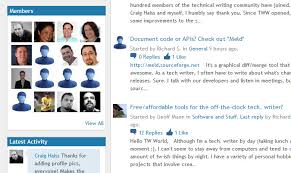Musings On Coming to Work
Posted on April 29, 2016
Filed Under Business, Communication, The Writing Life | Leave a Comment
Who are you? Even though you’re a technical writer, the question matters greatly. Technical writing isn’t supposed to be about psychology. It’s more typically about getting from here to there, providing directions, if you will.

Yet we all function in context and an essential part of that context is ourselves. We bring to work a history and collection of abilities and experiences that enabled, and keep enabling, us to succeed in the first place.
So before numbering steps, editing formulas or getting operational about a piece of equipment, remember that a given process starts with us and where we’ve been until now. What are we bringing to the scene that somebody else saw in us, or at least hoped they did, when they hired or assigned us?
What’s our state of readiness for the next move? We shouldn’t just plunge in, but be aware of alternative moves, some of which might be better, and some worse, but all potentially emanating from us, to an employer’s or client’s advantage.
Obvious thoughts? Probably. But how often do we expressly have them? Wouldn’t they be helpful as recurring prompters? Such meanderings have been stirred by a post on Bart D. Leahy’s blog, “Heroic Technical Writing”.
“My personal marketing advantage, for example,” Bart writes, “is Trust, which includes things like showing up on time, getting good work done on time, and being someone who takes the time to learn his clients’ work and priorities so that I write a better product.” How many of us actually do this last? How much do we actually know about a client’s needs and promptings before start serving them?
Inner precedes outer. Before we put words on a screen or paper, we need to be clear about where they’re coming from. Not just a setting, but the previously arrayed elements of that setting, including those internal to the people who created it.
We could get carried away at this point and start arguing that everything began with Adam and Eve. But no, an assignment begins with what’s gone into a particular setting, the setting in which we’re treading either with aplomb or caution.
Bart Leahy prompts these thoughts with his review of a book, “Fascinate: How to Make Your Brand Impossible to Resist.” For us as individuals the question becomes, “How do we make ourselves impossible to misunderstand or be misunderstood?” No small promptings, these. We need to be continually mindful of them. We need to be trustworthy.
We’re not just coming to work, but working in a given direction. Ours or our client’s? It needs to be the client’s, of course. – Doug Bedell
Virtual Reality An Opportunity For Well-Heeled Technical Writers
Posted on April 25, 2016
Filed Under Business, Communication, Education, Technology | Leave a Comment
Here’s a fascinating example of where technology is taking us – using virtual reality viewers to simulate whatever setting we care to experience and learn from. The thought occurred that this immersive technique might possibly be useful (and certainly engaging) to technical writers with a visionary bent.
 For example, the U.S. Navy at Pearl Harbor is using virtual reality at actual shipboard gun emplacements to detect and ward off simulated attackers. And there’s a paper available (by five writers) on “Teaching Technical Writing Using 3D Virtual Reality Technology.” We haven’t read it yet, and virtual reality gear may be expensive to acquire and use. But when you’re on a frontier, it’s good to be aware of the possibilities. The future, as we know, has a way of advancing rapidly.
For example, the U.S. Navy at Pearl Harbor is using virtual reality at actual shipboard gun emplacements to detect and ward off simulated attackers. And there’s a paper available (by five writers) on “Teaching Technical Writing Using 3D Virtual Reality Technology.” We haven’t read it yet, and virtual reality gear may be expensive to acquire and use. But when you’re on a frontier, it’s good to be aware of the possibilities. The future, as we know, has a way of advancing rapidly.
Suppose you work on a large site with lots of gear to monitor and use to its full operational advantage. With a virtual reality setup you could possibly simulate contexts of interest without leaving your desk. That could allow a highly efficient use of your creative energy. Of course, there’d be costs, possibly substantial ones, to get you to that point.
Or maybe you’d like to experience a setting that doesn’t yet exist. We don’t know what’s involved in programming virtual reality, but it’s likely that this scenario is already being experienced somewhere. “Here’s where we’re headed,” a VR practitioner is saying, “and no, we really don’t want to go there. Here’s why.” All without leaving your morning coffee.
The potential for teaching technical writing in a classroom setting using virtual reality is explored in the paper referenced above, whose writers are interested in providing “practical learning environments for students.” And Google can likely direct you to other pathbreaking instructional material on VR.
The point is, virtual reality is a new technique for exploration and learning. Freshness tends to become ever more intricate, so we’d suggest considering VR while it’s still an opening book for technical writers. – Doug Bedell
An Awesome Web Community
Posted on April 20, 2016
Filed Under Communication, Technology, The Writing Life | Leave a Comment
We need to tip our hat, or maybe more, to Technical Writing World, the “social network for technical communicators.” Yes, more – so we’ll blog a bit about the site. Why? Because it’s got over 2,800 members, and that’s great for a social network that’s not Facebook or Twitter.
What’s all this gushing about? Well, we’re halfway through our second reading of Mark Schaefer’s latest book, “The Content Code,” which describes in detail how hard it is to get discovered on the Web these days, and how it’s getting even harder.
What Technical Writing World’s impressive membership indicates is that technical writers are discovering each other in a world-wide community of engaged, conscientious people. We knew they were conscientious, of course, but to join and sustain a worldwide community like TWW is exemplary these days.
For the Web is like a vast sea that’s getting ever wider and deeper, one where it’s increasingly hard to be found and engage with other colleagues. We look at Technical Writing World and all sorts of sharing seems to be occurring there. There are 189 blog posts, 607 forum discussions, an upcoming event next month of the Society for Technical Communication, leaderboards to promote the most active members and their contributions, a Techcomm Superfeed with the latest blog posts from members, and postings of technical writing jobs. (Might this be a special reason for the site’s popularity?)
“I’ve spent the last year studying this essential concept of content ignition, Mark Schaefer writes in ‘The Content Code,’ and it has changed me. There is a science and psychology behind the act of sharing content that is awe-inspiring and beautiful and mesmerizing. People share content for hundreds of reasons, but there is a uniform process behind it inexorably linked to self-image, caring for others, and even compassion for an author or brand.”
Well, nobody seems in need of compassion on “Technical Writing World,” but it is indeed an awe-inspiring site, a testimony to the communal challenge, satisfaction and sharing behind technical writing taken seriously and collegially. – Doug Bedell
Ready, Write, Aim – No, That’s Not It
Posted on April 8, 2016
Filed Under Communication, The Writing Life | Leave a Comment

What’s the most important element in starting a technical writing task? (Or any other, for that matter.) Why, it’s your aim, of course. “What am I trying to accomplish with this? Where are we headed?” Putting first things first requires that you have a good fix on what you’re aiming for before you start doing it.
Don’t be the kind of writer who just tries to fill space – that won’t have a worthwhile outcome. We used to do editorial writing, with a wide column of empty space to be filled daily. But filling that space wasn’t, or shouldn’t have been, our aim. Having something to say was what benefitted readers, sharpened their perceptions and expectations of us. That was, or should have been, our real aim.
Such thoughts occurred (again) while reading Neal Caplan’s post “…You’re Not Good Enough.” Being judged by other people’s standards is okay, so long as you all have the same aim. But if you don’t, watch out. You may get to where they’re headed and find, pretty quickly, that it’s not where you need to be. It’s all in your aim.
Taking careful aim shouldn’t be any different for technical writers than anyone else. What in the way of writing crisp, efficient documentation should be your intent on behalf of those who will be using it? Don’t just start spieling out directions. They may get pretty roundabout.
“As nice as it is to hold a copy of a book that you wrote,” Neal notes, “it’s not so nice to tell your customers that they MUST read that book before they can use your product. Or, more likely, that shelf full of books. This is the opposite of ‘just in time’ help: it’s ‘become an expert on this product before you ever think about touching the UI.’”
Your aim isn’t to help colleagues become expert at what you’re doing, but to become better at what they’re trying to accomplish. There’s always more to discover, learn and know. The real question is: to what end? What are you aiming for, organizationally and individually? Keep focused on that; it’s what matters most. – Doug Bedell
Recently
- Presentations With Forethought
- Technical Writing’s Lineage – Surely It’s Deeper than Digital
- At the Holidays, Twitting Amazon
- Successful Cookie Baking – From Mom, an Acknowledged Expert
- Slides for a Tech Writer’s Craft
- Digital or Not, Be Clear
- Being Watchful About Digital Designs…
- When Proposals Don’t Click, Keep Making Them Anyway
- Like a Good Gardener, Help an Enterprise Keep Itself Current
- We’re Leaders All, And Need to Think That Way
Categories
Archives
- January 2017
- December 2016
- November 2016
- October 2016
- September 2016
- August 2016
- July 2016
- June 2016
- May 2016
- April 2016
- March 2016
- February 2016
- January 2016
- December 2015
- November 2015
- October 2015
- September 2015
- August 2015
- July 2015
- June 2015
- May 2015
- April 2015
- March 2015
- February 2015
- January 2015
- December 2014
- November 2014
- October 2014
- March 2014
- February 2014
- January 2014
- December 2013
- November 2013
- October 2013
- September 2013
- August 2013
- July 2013
- June 2013
- May 2013
- April 2013
- March 2013
- February 2013
- January 2013
- December 2012
- November 2012
- October 2012
- September 2012
- August 2012
- July 2012
- June 2012
- May 2012
- April 2012
- March 2012
- February 2012
- January 2012
- December 2011
- November 2011
- October 2011
- September 2011
- August 2011
- July 2011
- June 2011
- May 2011
- April 2011
- March 2011
- February 2011
- January 2011
- December 2010
- November 2010
- October 2010
- September 2010
- August 2010
- July 2010
- June 2010
- May 2010
- April 2010
- March 2010
- February 2010
- January 2010
